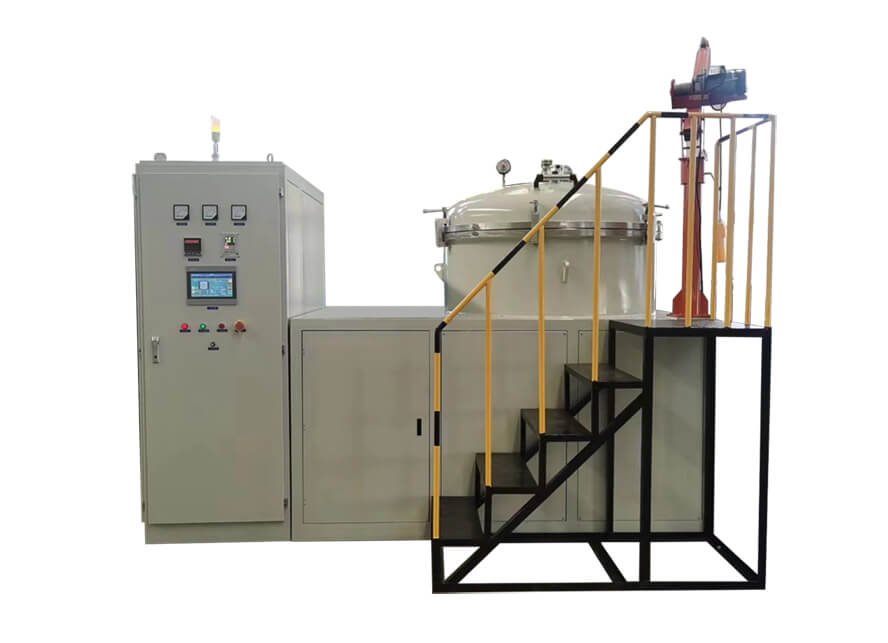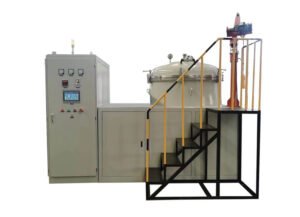The Chemical Vapor Deposition (CVD) process for producing carbon-carbon composites involves high-temperature chemical reactions where carbon source gases decompose and deposit carbon inside and on the surface of a carbon fiber substrate. This method is commonly used for manufacturing high-performance carbon-carbon composites, such as those used in aerospace applications, high-temperature structural components, thermal field components, and high-performance heat-resistant parts.
1. Basic Principle of CVD Process
CVD involves the following steps:
1.1 Carbon Source Gas Injection: Introduce carbon source gases such as methane (CH4), acetylene (C2H2), ethylene (C2H4), or benzene (C6H6) into a heated reactor.
1.2 Decomposition and Carbon Deposition: At high temperatures (typically 800-1200℃), the carbon source gases decompose and release carbon atoms, which deposit on the carbon fiber substrate, filling the pores and gradually forming a dense carbon structure.
1.3 Multiple Deposition Cycles: To improve the material’s density, strength, and high-temperature performance, carry out multiple deposition cycles typically. Each cycle of gas injection and deposition further enhances the carbon content of the material, reducing its porosity.
1.4 Final Graphitization in a graphitization furnace: After several cycles, the material is exposed to even higher temperatures (typically around 2000℃) in a final graphitization step to enhance its thermal conductivity and mechanical properties.

2. Detailed Steps of the CVD Process
2.1 Substrate Preparation
- Substrate Selection: Typically use carbon fibers (such as PAN-based or pitch-based carbon fibers) as the substrate. Prepare the carbon fiber substrate by weaving, winding, or layering to achieve the desired shape.
2.2 Gas Injection and Deposition
- Gas Source Selection: Common gases include methane (CH4), acetylene (C2H2), ethylene (C2H4), or benzene (C6H6), chosen based on the desired deposition rate and material properties.
- Deposition Conditions: Introduce carbon source gases into the reaction chamber under low pressure (1-100 Torr) and heated to high temperatures (typically 800℃ to 1200℃). The carbon atoms released from the gas react and deposit on the fiber surface.
2.3 CVD Deposition Process
- Pre-heating Stage: Heat the carbon fiber substrate to around 800-1200℃.
- Gas Injection: Introduce Carbon source gases and carrier gases (such as hydrogen or argon) into the reactor, with careful control over the flow rate, gas concentration, and pressure.
- Carbon Deposition: The gases decompose at the high temperature, and carbon atoms deposit on the fiber surface and within the pores, gradually filling the structure.
- Deposition Control: Temperature, gas concentration, and pressure are adjusted to optimize deposition rate and uniformity.
- Cooling and Post-processing: After deposition, the material is cooled, and post-treatment may be performed, such as surface treatments to enhance hardness.
3. Key Factors Affecting CVD Deposition Quality
3.1 Temperature
- 800-1200℃: Ideal for carbon deposition.
- Below 800℃: Deposition rate is too slow and ineffective.
- Above 1200℃: Carbon structure may change, affecting material performance.
3.2 Gas Flow and Pressure
- Low pressure (1-100 Torr) supports uniform deposition.
- High pressure may lead to uneven deposition and porosity.
- Low pressure can reduce the deposition rate, affecting production efficiency.
3.3 Gas Source Selection
- Methane (CH4): High purity, suitable for uniform deposition.
- Acetylene (C2H2): Faster deposition rate, but can lead to uneven structures.
- Benzene (C6H6): Used for specific high-density C/C composites.
4. Advantages and Disadvantages of the Chemical Vapor Deposition Process
4.1 Advantages
- High purity carbon deposition: CVD produces carbon layers with no impurities, leading to dense structures.
- Excellent high-temperature performance: Ideal for aerospace, semiconductor, and thermal field applications.
- Uniform microstructure: Produces dense, uniform carbon layers that enhance mechanical strength and thermal shock resistance.
- Controllable porosity: Allows for control of porosity, tailoring the material’s strength and thermal conductivity properties.
4.2 Disadvantages
- Slow deposition rate: The CVD process is slow, with complete deposition potentially taking several days or weeks.
- High production cost: The complex equipment and high consumption of carbon source gases make it a costly process.
- Requires precise control: Meticulously controls process parameters such as gas flow, temperature, and pressure to ensure uniform deposition.
5. Applications of Chemical Vapor Deposition-Produced Carbon-Carbon Composites
Due to their excellent high-temperature strength, low density, and outstanding thermal conductivity, CVD-produced carbon-carbon composites are used in:
- Aerospace: Thermal protection systems for spacecraft, rocket nozzles, and aircraft brake discs.
- Semiconductor industry: High-temperature parts for silicon crystal growth furnaces, graphite heaters.
- Nuclear and defense: Nuclear reactor components and high-temperature fuel containers.
- High-temperature furnaces: Components for vacuum furnaces, graphite heating elements.











